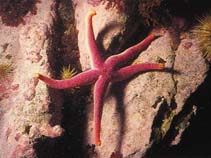Henricia sanguinolenta (Müller, 1776)
Blood sea starWarning: DOMDocument::load(): SSL operation failed with code 1. OpenSSL Error messages: error:140770FC:SSL routines:SSL23_GET_SERVER_HELLO:unknown protocol in C:\Apache24\htdocs\includes\SpeciesSummary.lib.php on line 1236
Warning: DOMDocument::load(): Failed to enable crypto in C:\Apache24\htdocs\includes\SpeciesSummary.lib.php on line 1236
Warning: DOMDocument::load(https://sealifebase.nrm.se/webservice/AquaMaps/getAMap.php?genus=Henricia&species=sanguinolenta): failed to open stream: operation failed in C:\Apache24\htdocs\includes\SpeciesSummary.lib.php on line 1236
Warning: DOMDocument::load(): I/O warning : failed to load external entity "https://sealifebase.nrm.se/webservice/AquaMaps/getAMap.php?genus=Henricia&species=sanguinolenta" in C:\Apache24\htdocs\includes\SpeciesSummary.lib.php on line 1236
Classification / Names Common names | Synonyms | CoL | ITIS | WoRMS
| Spinulosida | Echinasteridae
Environment: milieu / climate zone / depth range / distribution range Ecologia
; intervalo de profundidade 0 - 2400 m (Ref. 865), usually 50 - 150 m (Ref. 125153). Temperate; 80°N - 40°N, 170°W - 45°E
Distribuição Países | Áreas FAO | Ecossistemas | Ocorrências | Introduções
Eastern Pacific, North Atlantic and the Arctic: North Sea and the Canadian Arctic Archipelago.
Length at first maturity / Tamanho / Peso / Idade
Maturity: Lm ? range ? - ? cm Max length : 15.0 cm WD macho/indeterminado; (Ref. 865)
It is found on rocks and soft bottoms in subtidal areas to a depth of 2,400 meters (Ref. 865). A carnivore; trophic level 3.1 (Ref. 96418). Feeds on at least 12 species of sponges and a common food item is Isodictya spp. (Ref. 96505). Occasionally relies on filter-feeding, specifically during summer and autmn. Opportunistic generalist predator (Ref. 130743).
Life cycle and mating behavior Maturidade | Reprodução | Desova | Ovos | Fecundidade | Larvas
The females brood their eggs (Ref. 865).
Referência principal
Referências | Coordenador | Colaboradores
Jennings, S., J. Lancaster, A. Woolmer and J. Cotter. 1999. (Ref. 3123)
Status na Lista Vermelha da IUCN (Ref. 130435)
Status no CITES (Ref. 108899)
Not Evaluated
CMS (Ref. 116361)
Not Evaluated
Perigo para os humanos
Uso pelos humanos
| FishSource |
Ferramentas
Mais informação
Fontes da internet
BHL | BOLD Systems | CISTI | DiscoverLife | FAO(Publication : search) | Fishipedia | GenBank (genoma, nucleotídeo) | GloBI | Gomexsi | Google Books | Google Scholar | Google | PubMed | Árvore da vida | Wikipedia (Ir para, procura) | Registro zoológico
Estimates based on models
Preferred temperature
(Ref. 115969): 1.6 - 9.8, mean 4.6 (based on 408 cells).
Categoria de preço
(Ref. 80766):
Unknown.



